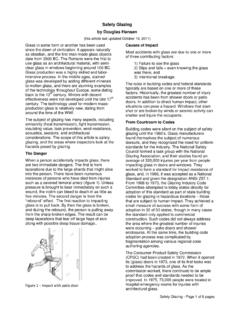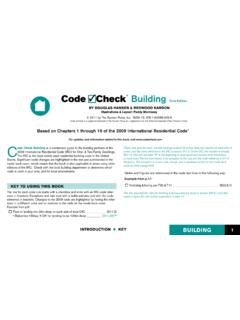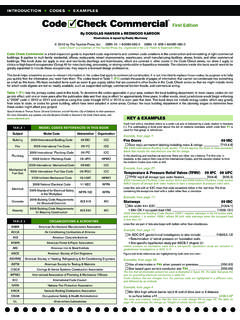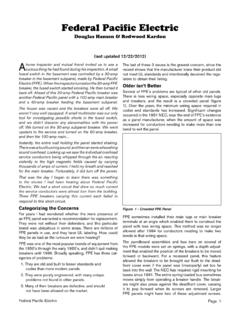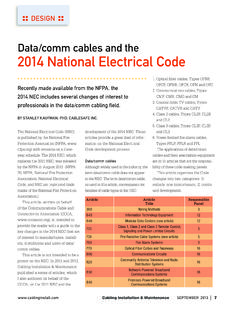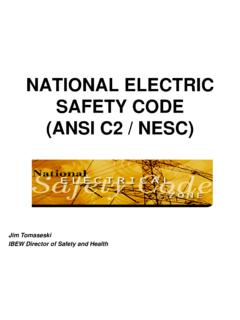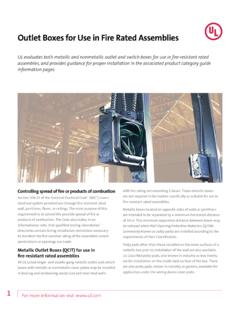Transcription of INTRODUCTION CODES ABBREVIATIONS Code …
1 A = amp(s) (ex: a15A breaker)ABS = acrylonitrile-butadiene-styrene plastic pipeACH = air changes per hourAHJ = authority having jurisdictionAMI = in accordance with manufac-turer s instructionsASCE = American Society of Civil EngineersASTM = American Society for Testing & MaterialsAWG = American Wire GaugeB (vent) = gas appliance vent, usually double-wallBO = building officialBtu = British thermal unitBWL = braced wall lineBWP = braced wall panelCATV = cable televisioncfm = cubic feet per minuteCPVC = chlorinated polyvinyl chloride plastic pipeCSST = corrugated stainless-steel tubingcu. = cubic (ex: 24 cu. ft.)Cu = copperDFU = drainage fixture unit(s)DW = dishwasherDWV = drain, waste & = for example (exempli gratia)EGC = equipment grounding conductorEMT = electrical metallic tubingex: = exampleFAU = forced-air unit (central furnace)FLR = flood level rimFMC = flexible metal conduit ft.
2 (after number) = foot, feet (ex: 5 ft.)FVIR = flammable-vapor ignition-resistantgalv = galvanizedGB = gypsum boardGEC = grounding electrode conductorGPM = gallons per minute hp = horse power INTRODUCTION u CODES u ABBREVIATIONSABBREVIATIONS ICF = insulating concrete formsIMC = intermediate metal conduitin. (after number) = inch(es) (ex: 24 in.)IS = IAPMO Installation Standardkw = kilowattL&L = listed & labeledlav = lavatory (bathroom sink)lb. = poundLFMC = liquidtight flexible metal conduitLFNC = liquidtight flexible nonmetallic conduitLL = lot line dividing one lot from another or from a street manu = manufacturermax = maximummin = minimummph = miles per hourn/a = not applicableNM = nonmetallic sheathed = on centerPEX = cross-linked polyethylene plastic pipe (water pipe)psf = pounds per square footpsi = pounds per square inchpsig = pounds per square inch gaugePT = Preservative-treated (wood)PVC = polyvinyl chloride plastic water pipe or electrical conduitrecep = receptacle outlet (electrical)RMC = rigid metal conduitSDC = Seismic Design CategorySDC D = SDC D 0, D1, & D2SE = service entrancesq.
3 = square (ex: 24 sq. in.)UL = Underwriter s Laboratories, = electrical conductors rated for wet locationw/ = withw/o = withoutWC = water closet (toilet)WH = water heaterWSFU = water supply fixture unit(s)Zi = ZincCODES REFERENCED IN code CHECK OrganizationCodeICC 2009 & 2012 IRC International Residential code IAPMO 2009 & 2012 UPC Uniform Plumbing code IAPMO 2009 & 2012 UMC Uniform Mechanical code N F PA 2009 & 2011 NEC National Electrical code The code changes referenced on the inside back cover compare the most recent CODES in this table to the earlier editions. code 3 Check Seventh EditionBy DOUGLAS HANSEN & REDWOOD KARDONI llustrations & layout by Paddy Morrissey 2012 by The Taunton Press, Inc. ISBN XX X-XXXXX-XXX-X ISBN XX XXX-X-XXXXX-XXX-XCode Check is a trademark of The Taunton Press, Inc., registered in the Patent & Trademark Office.
4 Printed in ChinaCode Check is a field inspection guide to important code requirements and common code violations in the construction of 1- & 2-family dwellings & townhouses. The primary reference is the 2012 edition of the International Residential code for One- and Two-Family Dwellings, published by the International code Council (the IRC). CODES are adopted at different times in different places around the country. New editions come out every three years, and some states make extensive modifications to the model CODES prior to adoption. Since the code used in a particular area could vary, we include references to the two most commonly used CODES for every item in the book. Significant code changes are highlighted in the text and summarized on the inside back cover. For users in areas still using the 2009 IRC, the building section of the book cites both the 2009 and 2012 references.
5 To determine the CODES in your area, contact your local building department and check our web site at For updates to this book, and other valuable news, articles, and information, visit code ORGANIZATIONS ICC = The International code Council IAPMO = International Association of Plumbing and Mechanical Officials N F PA = National Fire Protection AssociationThe IRC is a prescriptive guide to residential construction. It is intended primarily for wood-frame conventional construction within prescribed height limits and areas of wind and seismic design. When a project has aspects that exceed the prescriptive limits of the IRC, those aspects require an engineered design. Many houses will require design for certain specific portions, while the majority of the construction can be built prescriptively using the IRC. Some projects might be in wind, snow, or seismic areas that require all of the structural aspects be built to the International Building code (IBC), while the nonstructural aspects are built to the IRC.
6 The information in this document is believed to be accurate; however, it is provided for informational purposes only and is not intended as a substitute for the full text of the referenced CODES . Publication by The Taunton Press, ICC, and the authors should not be considered by the user to be a substitute for the advice of a reg-istered design professional. Contact the local building department to learn what CODES apply in your area as well as any local amendments and TO USING code CHECKEach item with a checkbox refers to a code rule, and is followed by code cita-tions. In the building section, most sections have only one column of code cita-tions and they reference the numbers from the 2009 & 2012 IRC. Two columns of references are used when the 2009 & 2012 IRC used different numberings. In the plumbing, mechanical, and electrical sections the left citation is from the 2012 IRC, and the right column is from the 2012 UPC, 2012 UMC, or 2011 NEC.
7 Example from :Indoor Air as Sole Source 12 IRC 12 UMC Min volume of space 50 T18, F55 ____[ ] { }This line says that appliances deriving all their combustion air from indoors must have a space at least 50 cu. ft. for each 1,000 Btu of the appliance rating. The rule is found in section of the IRC and of the UMC. It is also shown in Table 18 and Figure 55. When the code line text ends in EXC an exception follows the main rule, as in this example from Valve ahead of union & 6 ft. of appliance F41,42 EXC _[ ] { } 50 ft OK if accessible identified valve at manifold ___[ ] { }This line says that a gas shutoff valve is required within 6 ft. of each appliance, as shown in figures 41 & 42. The IRC has an exception that allows the valve to be 50 ft. from the appliance at an accessible labeled manifold. The UPC prohib-its this practice, so the reference in that column is.
8 code changes from the previous code edition are shown by placing the refer-ence in a different color, and a superscript endnote to the table on , as in this example from Pan not req d under tankless WHs _____[ ]51 {n/a}The IRC does not intend to require a drain pan under a tankless water heater. The UPC does not have this rule, so it s reference is n/a . This change is ex-plained as change #51 on dimensions, 2 x 4 , are nominal dimensions unless including a fraction or otherwise stated. BUILDING PLANNING u BUILDING LOCATION 1 PLANNINGP lans, Permits & Inspections 09 & 12 IRCn Approved plans & permit card on site _____[ ]n Permits req d for all work EXC _____[ ] 1-story accessory structures 200 sq. ft., fences 7 high, retaining walls 4 ft. from bottom of footing to top of wall, water tanks on grade 5,000 gallons, sidewalks, driveways, painting, countertops, similar finish work, window awnings projecting 54 in.
9 , decks 200 sq. ft. & 30 in. above grade & not serving req d exit door _____[ ]1n Inspection & approval prior to covering any work _____[ ]Design n Engineered design per IBC OK as alternative to IRC _____[ ]n Determine climatic and geographic design criteria _____[ ]n AHJ to determine wind speed from maps & topography _____[ ]n Special design ( ASCE-7 or ICC-600) where maps indicate special wind regions or basic wind speed > 110 mph _____[ ]2n AHJ to determine seismic design category from IRC maps_____[ ]n AHJ may allow alternate determination of SDC E if all shear walls extend from foundation to top story & no cantilevers or irregularity _____[ ]Benjamin Franklin was chosen as the main character in our code Check illustrations for a number of reasons. The First American s insatiable curiosity, scientific genius, and civic-mindedness drove him to study fire safe-ty, safe exiting, public sanitation, improved heating methods, and of course, electricity.
10 Franklin made major contributions to each of the four main disciplines of building inspec-tion: Building, Plumbing, Mechanical, and Electrical. To find out more, LOCATIONS etbacks F1 09 IRC 12 IRCn Verify setbacks unrated walls min 5 ft. to LL EXC ___[ ] { (1)} 3 ft. if compliant automatic sprinkler system present ____[n/a] { (2)}3n No openings in walls < 3 ft. to LL EXC _____[ ] { } Openings in walls perpendicular to LL OK _____[ ] { } Facing dwellings & accessory structures on same lot [ ] { } Accessory structures that are exempt from permits [ ] { } Foundation vents _____[ ] { }n Openings up to 25% of wall area OK > 3 ft. & 5 ft. EXC _[ ] { } No limit > 3 ft. if automatic sprinkler system present ____[n/a] { (2)}4n Projections (eaves) min. 5 ft. from LL EXC _____[ ] { (1)} 2 ft.

